Light: Reflection & Refraction - Class 10th Science
Image Formation by Concave Mirror
To find the position of image formation by a mirror, at least two rays are taken into consideration. One ray is generally taken which directs parallel to principal axis and second ray which passes through centre of curvature. The meeting point of these rays is considered as the position of image.
(a) When object at infinity in the case of Concave Mirror
Rays coming from object at infinity are parallel to principal axis, and converge at Principal Focus of Concave Mirror after reflection.
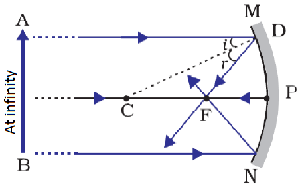
Position of Image: Since rays converges at Principal focus, thus image is formed at Focus, F
Size of Image: Highly diminished and point size.
Nature of Image: Real and Inverted
(b) When object is beyond Centre of Curvature (C)
When object is placed beyond the centre of curvature, rays from object pass through principal focus as image formed between principal focus and centre of curvature.

Position of image: Between Principal Focus (F) and Centre of Curvature (C)
Size of Image: Diminished
Nature of Image: Real and Inverted
(c) When object is at centre of curvature (C)
When object is placed at the centre of curvature, image formed at the same place, i.e. at the centre of curvature (C), but just opposite to it.
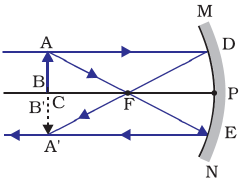
Position of image: At Centre of Curvature (C)
Size of Image: Same size
Nature of Image: Real and Inverted
(d) When object is between Centre of Curvature (C) and Principal Focus (F)
When object is placed between Centre of Curvature (C) and Principal Focus (F) of a concave mirror, in this case image is formed beyond Centre of Curvature (C).
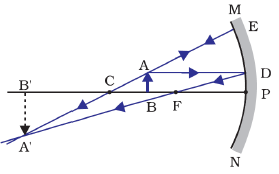
Position of image: Beyond Centre of Curvature (C)
Size of Image: Enlarge
Nature of Image: Real and Inverted
(e) When object is at Principal Focus (F)
When object is placed at Principal Focus (F) of a concave mirror, image is formed at infinity.
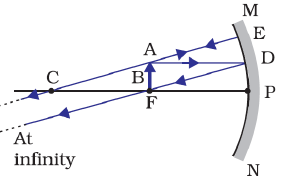
This is just opposite of the position of object at infinity. Image formed at principal focus (F) when object is placed at infinity, just opposite of it image formed at infinity when object is placed at principal focus (F) by a concave mirror.
Position of image: At infinity
Size of Image: Highly Enlarge
Nature of Image: Real and Inverted
(f) Image formation by a Concave Mirror when object is placed between Pole (P) and Principal Focus (F)
When object is placed between pole (P) and principal focus (F), image is formed behind the mirror by a concave mirror.
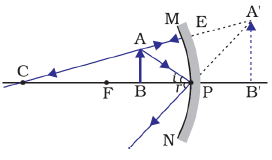
Position of image: Behind the mirror
Size of Image: Enlarge
Nature of Image: Virtual and Erect
| Image Formation by a Concave Mirror | |||
|---|---|---|---|
| Position of Object | Position of Image | Size of Image | Nature of Image |
| At infinity | At Focus (F) | Highly diminished (Point sized) | Real and Inverted |
| Beyond C | Between F & C | Diminished | Real and Inverted |
| At C | At C | Same size | Real and Inverted |
| Between C and F | Beyond C | Enlarged | Real and Inverted |
| At F | At infinity | Highly Enlarged | Real and Inverted |
| Between P and F | Behind the mirror | Enlarged | Virtual and Erect |
Use of Concave Mirror
Concave mirror is used in torches, search lights and vehicles head lights. In these lights, bulb is kept at the principal focus of concave mirror. This gives parallel beams of light.
Concave mirror is used in shaving mirrors to see a larger image of face.
Concave mirror is used by dentists to see the larger image of teeth of patient.
Large Concave mirrors are used in solar furnace to concentrate the sunlight to get heat. Large concave mirror has large aperture, due to which it reflects more sun light and concentrate at focus which give large amount of heat.
Image Formation by Convex Mirror
Since, Principal focus (F) and Centre of Curvature (C) lie behind a convex mirror. Therefore, only two positions arise to place object infront of a Convex Mirror.
These positions are
(a) Object at infinity, and
(b) Object between pole (P) and infinity
(a) Image formation by a Convex Mirror when object is at Infinity
When object is placed at infinity, rays coming parallel to principal axis appear to converge at principal focus (F) after reflection from a concave mirror. Thus, image formed at principal focus (F) by a concave mirror.
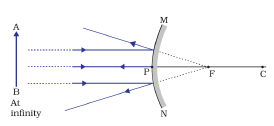
Position of image: At principal Focus (F)
Size of Image: Highly diminished (Point sized)
Nature of Image: Virtual and erect
(b) Image formation by a Convex Mirror when object is between pole (P) and infinity
When object is between pole and infinity, image is formed between pole (P) and principal focus (F) by a convex mirror. Image so formed by a convex mirror is virtual, erect and diminished.
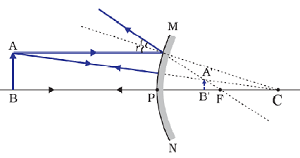
Position of image: Between pole (P) and principal focus (F)
Size of Image: Diminished
Nature of Image: Virtual and erect
Use of Convex Mirror
Convex mirror is used as rear view mirror in vehicles. Convex mirror fitted at the sides of vehicles enable driver to see traffic behind. By watching and judging traffic behind a driver can drive safely. Concave mirror is perfect as rear view mirror in vehicles as it gives an erect image. Concave mirror has wider field of view also. So, a concave mirror is preferred to a plane mirror as rear view mirror.
Concave mirror is used at steep curved path, to see the vehicles or anything coming from other side.
Sign Convention of Reflection by Spherical Mirror
Set of sign convention of reflection by spherical mirror is called New Cartesian Sign Convention also.
Rules of New Cartesian Sign Convention
The pole (P) of the mirror is taken as origin. The principal axis of the mirror is taken as the x–axis of the coordinate system. The conventions are as follows:
(i) The object is always placed to the left of the mirror. This implies that the light from the object falls on the mirror from the left hand side.
(ii) All distances parallel to the principal axis are measured from the pole of the mirror.
(iii) All the distances measured to the right of the origin (along + x–axis) are taken as positive while those measured to the left of the origin (along – x–axis) are taken as negative.
(iv) Distances measured perpendicular to and above the principal axis (along + y–axis) are taken as positive.
(v) Distances measured perpendicular to and below the principal axis (along – y–axis) are taken as negative.
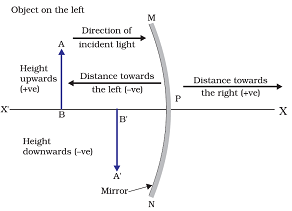
Mirror Formula and Magnification
There is relationship among distance of object (u), distance of image (v) and focal length (f) for a mirror, which is expressed as

Where, u = distance of object from pole of mirror
v = distance of image from pole of mirror
f = focal length (distance between principal focus and pole)
Expression for the relationship among distance of object (u), distance of image (v) and focal length (f) for a mirror is called mirror formula.
This mirror formula is valid in all situations for all spherical mirrors for all positions of the object.
By knowing any two quantities, third can be calculated using mirror formula.
Magnification
Magnification produced by a spherical mirror gives the relative extent to which the image of an object is magnified with respect to the object size.
Magnification is expressed as the ratio of height of the image to the height of the object. Magnification is conventionally expressed by letter 'm'.
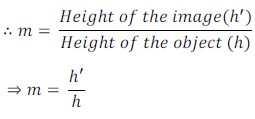
Magnification is related to the distance of object (u) and distance of image (v) also. The ratio of distance of image and distance of object gives magnification too.
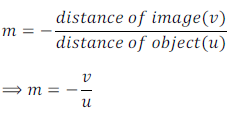
Thus, by knowing the distance of object and image produced by a spherical mirror, magnification can be calculated.
Images are taken from NCERT Book Class 10 Chapter: Light: Reflection and Refraction